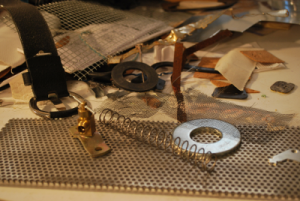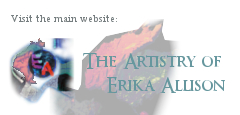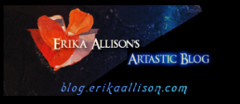Erika Allison's Artastic Blog
Breaking the rules… or not
Archive for July 24th, 2010
I love texture! It’s an element that I think adds lots of interest to my work. I start with texture right from the beginning with the gesso. I apply the gesso with a cheap bristle brush and slather it on every which way, which leaves brush strokes that overlap. I don’t try to smooth it out or lay it on all in one direction. I’m looking for spontaneous strokes with lots of variety. If I were doing a portrait or landscape, this would be disastrous. I’d want to apply the gesso “properly” in a nice even coating, with no brush strokes showing. I’d sand between the two or three coats of gesso before starting my painting. BUT, I’m bucking tradition with my abstract mixed media work. I’m experimenting. I’m looking for new and different ways to work. I’m watching how my different materials react with each other. And, I’m looking for rich texture in the end. It’s reasonable, then, to START with texture.
There are many ways to achieve texture. Preparation of the painting surface is the place to start. I usually adhere different materials to the surface, experimenting with achieving different results. Then, there’s the application of the paint. Oils can be applied in a thick impasto, leaving raised areas where it’s the thickest. Materials can be “added” to the wet surface, as in throwing sand on it. There’s room for experimentation along the way. One thing I do consider is that my materials are archival. That sometimes leaves out interesting things I’d like to try. A lot of materials that would seem to make for interesting collage are really not at all archival. Newsprint doesn’t last long, nor do a lot of commercial printing inks that you’d find in newspaper or magazine pages.
Found objects can be attached to a painting during the process of creating the work – or after it’s finished. I love finding old, worn metal objects, rich with patina. There’s no end to the possibilities of texture in found objects. Pieces of screen or found jewelry components or hardware can all add interest. Or – you can create what is needed to meet your specific needs.

One method of creating texture is possibly overlooked. And, that is visual texture. Spray paint sprayed through a stencil or mask would be an example of what I’m talking about. The paint isn’t actually textural. It’s not raised. But, VISUALLY, it’s textural. And, that creates variety. Variety is always good. Too much of a good thing can be boring. Introducing a different approach or method will break up the monotony of too much of the same old thing. Stamping is another example of using visual texture. Some of my found objects have served me better as stamps than additions. And, of course, there’s dragging textural tools through the wet paint, creating grooves and furrows and scraping paint off to reveal colors beneath.

12.2
oil/mixed media on panel
12″x12″x2″
I’m guessing that you can come up with many other ideas on how to achieve texture. In art, the possibilities are endless. That’s the fun of it, the challenge…to find new ways.

